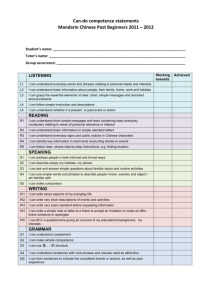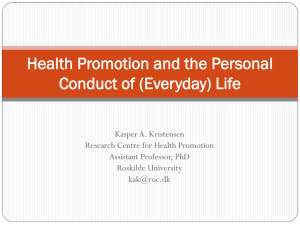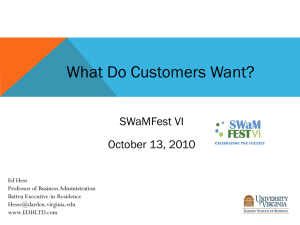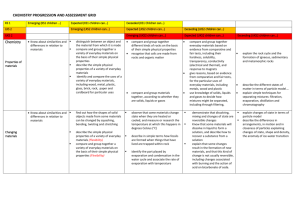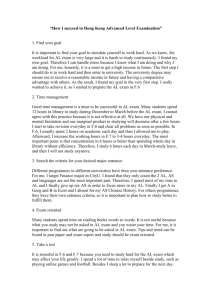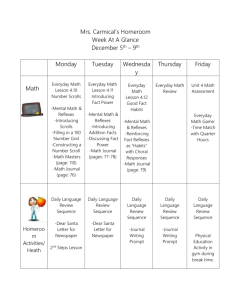Lesson plan for session 1
advertisement
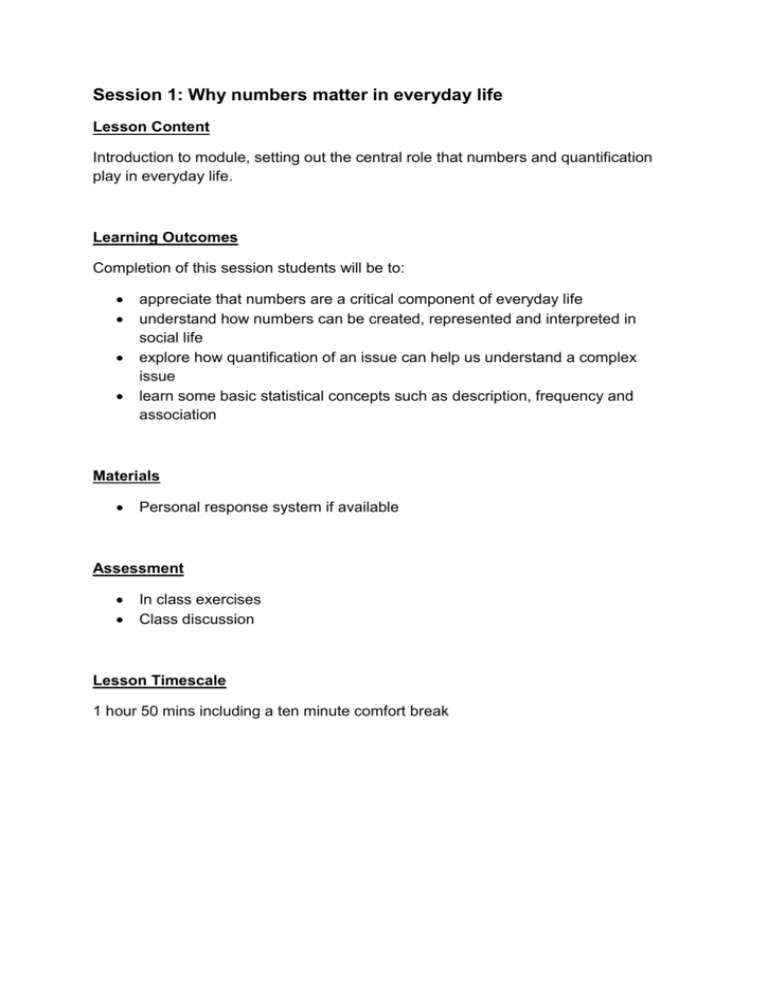
Session 1: Why numbers matter in everyday life Lesson Content Introduction to module, setting out the central role that numbers and quantification play in everyday life. Learning Outcomes Completion of this session students will be to: appreciate that numbers are a critical component of everyday life understand how numbers can be created, represented and interpreted in social life explore how quantification of an issue can help us understand a complex issue learn some basic statistical concepts such as description, frequency and association Materials Personal response system if available Assessment In class exercises Class discussion Lesson Timescale 1 hour 50 mins including a ten minute comfort break Lesson plan Time Activity Resource 5 min Introduction to module and purpose of (Slides 2 & 3) today’s session 10 min 10 min Using Numbers in Everyday Life – the Discussion in pairs mobile phone Class discussion (Slide 4) Quick fire quiz about relevance and Personal response system importance of numbers in everyday life (Mix of Yes/No and Multiple Choice questions, such as ‘Which supermarket did you last shop in?’) (Slides 5-10) Lecture on loyalty cards (Slides 11 & 12) 10 min Video on statistics from Gapminder Online video (Slide 13) “The Joy of Stats” 5 min Definition of number, statistic, (Slide 14) quantification 20 min 10 min Demonstration of 3 different types of Web resources data: Small group exercise – ‘Why is - data on where do millionaires live this information relevant and how - data on GCSE rates over time might this information be used?’ - data on hate crime in England (Slides 15-17) Using numbers to quantify (Slides 18-20) Using numbers to describe Using numbers to explain 20 min Statistics as a social construction Statistics as a social construction (Slides 21-22) “The example of educational outcomes (Slides 23 - 25) and ethnicity” 10 mins Conclusion (Slide 26) Lecturer Notes Slide Notes to Lecturer Number 1 Cover slide 2 Title slide 3 Learning outcomes for this session 4 With the person sitting beside them, ask students to discuss what factors influenced their choice of their current mobile phone. How they know they were getting good value? How did they make comparisons between different deals? After 5mins open the discussion and ask some trigger questions: - what length of contract did you choose and why? - what combination of talk/texts/data did you go for and why? - How did you work out whether you would pay too much with different providers? 5-10 Either using the Personal Response System (if available) or asking students to put up their hands, work through the questions. 11 Discuss how some supermarkets have developed loyalty cards as a means to hold onto customers, and that it can been seen as benefitting both retailers and shoppers. However, the information gathered through comparing our shopping habits with our demographic details can also be used for other purposes. 12 By analysing who buys what and when supermarkets can try to influence our shopping habits. Ask if any of the students work in a supermarket and if they have any examples of how supermarkets might use this type of information? 13 Show the first 4mins 30 secs of the Gapminder video with Hans Rosling (up to the bit about Noble prize winners being no more intelligent than chimpanzees). This just highlights how numbers are part of everyday life – you might want to encourage the students to watch the whole video in their own time 14 Definitions – an explanation of some key terms 15 Click through to The Guardian datablog – this slide is meant to highlight how data could be presented in different ways. For example, the right hand map shows the number of multimillionaires in the cities, while the left hand map shows the number of multimillionaires per 100,000 people in each city (Aberdeen has more multimillionaires per person than London!). Learning point – how data is presented can tell different stories 16 This slide shows how data can answer some questions (have rates of GCSE passes changed over time), without necessarily providing an explanation as to why. Learning point – data sometimes needs to be supplemented by other types and sources of information. 17 Click through to The Guardian datablog – this slide highlights how data can be manipulated to tell a more complex story. In this case the drop down menu lets us look at how different types of hate crime are apparent in different parts of England. Learning point – we need to sometimes go beyond the headline figure/statistic to better understand what might be happening. 18-20 Using data from National Statistics these slides helps students to think about how we might use numbers: Quantify – eg how many people live in different parts of the UK Describe – eg what is the gender and age profile of people in the UK Explain – eg how much has the population increase in the UK been due to migration Learning point – the questions we pose may require different types or presentations of data 21-22 This leads onto a discussion about the social construction of statistics. This slides asks students to think about the act of speeding whilst driving – a common occurrence, even though illegal. How does society define what is the permissible speed for any piece of road? When does the act of speeding become a crime – when we speed or when we are caught? How should the police respond? When should someone be cautioned or prosecuted? Ask for comments on these issues from the class 23 A worked example of how statistics can help in our understanding of a complex issue: Educational outcomes and ethnicity There is some statistical evidence that children from BME communities in London achieve lower educational outcomes than other children. Ask class - Why might this be? 24 But even within London some communities perform worse than others – why might this be? Are the factors at the level of the individual child; the school or the wider community? For example, African Caribbean children in Hackney do less well than African Caribbean children generally in London 25 A number of factors at play including whether children speak English, the level of social deprivation in the community, how settled schools are and whether teachers expect more or less of some pupils. Learning point – statistics need careful interrogation in order to unpack an issue and inform our understanding and ultimately allow us to intervene more effectively 26 Recap learning outcomes and preview the next session 27 Activity title slide 28-29 Activity Part A 30 Activity Part B 31 References
